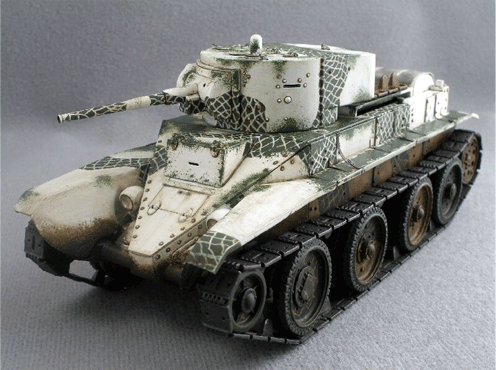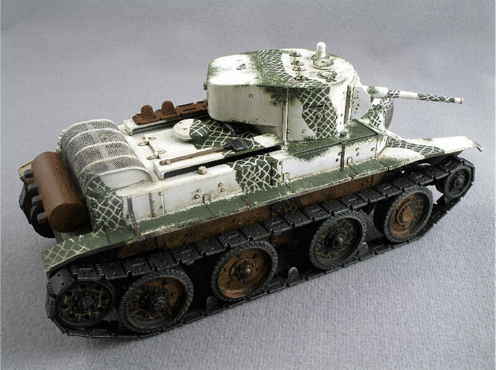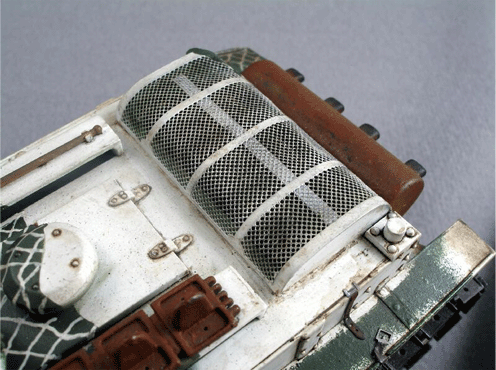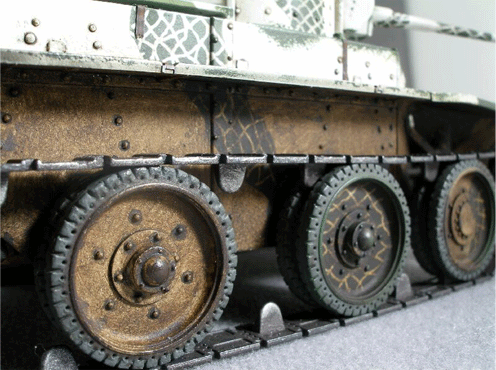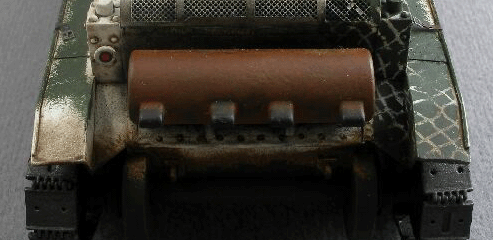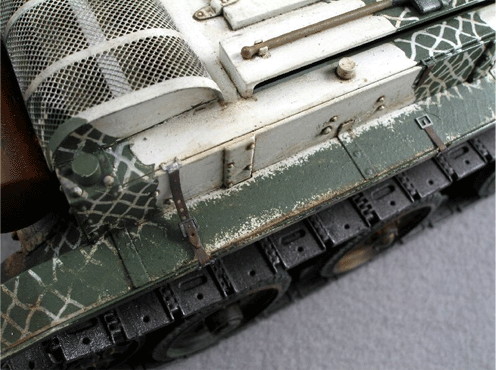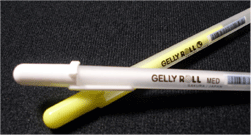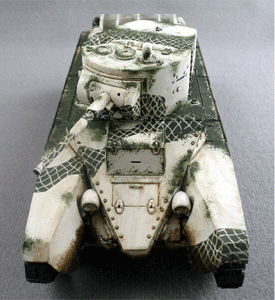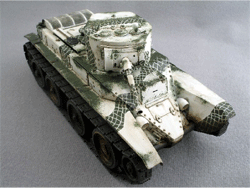
          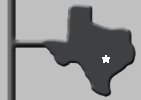
|
A Gelly Rolling BT-5By Eric Choy, ASMS Newsletter Editor, IPMS #44323
The Soviet BT (fast tank) was a lightly armored tank based on J. Walter Christie's suspension system. Similar to Christie's M1928, it was capable of switching from tracked to wheeled mode (by simply removing the tracks and engaging the drive train to the back road wheels) to allow the tank to travel faster on road surfaces. Over 7900 BTs were produced, and they saw action in the Spanish Civil War, Winter War in Finland, and the early stages of World War II. The BT-5 variant, with a 45mm cannon and coaxial machine gun, was introduced into the Red Army in 1933. My model of a BT-5 was finished in winter season camouflage designed to simulate tire tracks on snow observed from the air. Despite efforts to introduce this camouflage as a standard for all Soviet vehicles, only a few armored divisions painted their tanks (mostly model 1941 T-34s and BT-5s) in this unusual scheme. The Kit This 1/35th scale Italeri/Zvezda BT-5 was one of my many abandoned projects from way back. Originally I planned on using it for an early Barbarossa diorama. The quality of this kit leaves much to be desired; the fit is poor with significant gaps everywhere, and many detail parts are incorrect and oversized. And then there are those horrific tracks. No wonder I lost interest in building it. After spending many winters on my shelf collecting dust, my BT-5 finally received its call of duty last year. Bowing to my peers' "encouragement" to fill the tables of the AABS 2007 Centex show, I decided to finish it in the unique camouflage scheme described above to participate in the show theme build. The cross-hatching pattern presented an interesting obstacle in completing this project. I first contemplated making custom pattern decals to tackle it. But then I realized this involves printing white decals on an ALPS printer and spending many hours in front of a computer drawing lines. None of these seemed appealing to me. As I do not possess the skill to paint thin lines with a double/triple zero brush, the other alternative is the mask-and-paint method. I tried different ways to make masks (masking tape, wire screen, and even a woman's fishnet stocking!), but nothing worked. I was left with my final option: give up and return the tank to where I found it on the dusty shelf. Then one day while shopping at Jerry's Artarama, I came across these "Gelly R@ll" ink pens by Sakura. They come in all sorts of colors, including white, and the ink is thick and opaque enough for model work. All sorts of light bulbs went off in my head, and my project was back on track, literally.
Construction Before I got to play with my new gel pen, I had to finish building the BT-5 first. Fortunately, most of the work was already done, except for the wheels and tracks. It took a while to clean all the seam lines on all the road wheels and to cut out the track links from the sprue. While I was at it, I scratchbuilt the rear fenders as I did not like the look of the kit parts. Also, the headlights were way too small, so I replaced them with the ones from Italeri's Katyusha truck along with new MV lens. All my references show BT-5 has a brake light on the rear panel next to the muffler. I added one from my spare parts box accordingly. I couldn't resist using the beautiful engine grill on the Eduard detail set I picked up dirt cheap at Squadron's open house last year. The only drawback of using this PE screen was one can see right through into the big empty engine compartment. Having no desire to scratchbuild the engine, I used photos of a BT-5 model in Tanks in Russia II (Accion Press/Euro Modelismo) as a guide and built the louvers a la "T-34 style" to block the view of the abyss. I was happy with the result.
Painting The first coat of paint applied was Tamiya Primer White. After leaving the model a day to dry, I used Silly Putty for masking and sprayed my Russian Green (Humbrol 114) camo pattern. Another day of drying and now the fun began. Using my "Gelly R@ll" pen, I drew the cross-hatching lines on to the greens. Sometimes the tip of the pen picked up residues of the green paint and blocked the flow of the white ink. When that happened, I simply wiped the tip clean with a cloth, scribbled a few lines on a notepad to get the ink going, and I was able to continue my "drawing". That was how the white lines were done, and yes, it was that simple. Just to be on the safe side, I left the model alone for a few days for the gel ink to dry. Meanwhile, I painted the track links in MMIR track color (2 parts XF-1 + 1 part XF-16 + 1 part XF-9) and the rubber rim of the road wheels in RLM66. Weathering To simulate the chipping of the hastily applied winter camouflage, I used the "sponge method" to apply straight out-of-the-tinlet Russian Green on high traffic areas. In retrospect, I "sponged" too much and went crazy in many areas that were not supposed to be "sponged". Oh well, you live and learn. To vary the tone of the white and green on my BT-5, I decided to try Mig Productions Allied Filter set (P247). It comes with three 35ml bottles of heavily diluted colors: Brown for Dark Green, Grey for Bright Green, and Green for Light Green. I only used the first one for my tank, and the result was not very obvious. At this point the Centex show was less than a week away, and I did not wish to conduct further experiment with this new product. So I just left it alone and moved on. After applying the filter, the entire lower hull received a very muddy finish by drybrushing raw umber oil paint on everything below the fenders. Undiluted oil paint gives you plenty of working time (it took three days for the "mud" on my tank to dry), but beware not to leave any fingerprints on the unctuous surfaces.
Using the same color but this time diluted with Testors thinner to a wash consistency, I applied the mixture to all recess areas and around the rivets on the upper hull and the turret. Worn down handles and corners were rubbed down with a silver pencil, but the color failed to shine in the company of the white on the tank. Once everything was dried, I sealed the entire tank with a spray of dull coat. No weathering is complete without applying pigment here and there. In this case, the "here" is the engine grill (Smoke), and the "there" is the huge muffler (Old Rust, Flesh Rust, and Smoke). Prior to applying the pigment, I painted the muffler Russian Green and drybrushed with Testors ModelMaster Rust to suggest that at one point in time it was the same color as the rest of the tank.
Final Construction I tried both top-down and bottom-up approaches when installing the kit's tracks, and I always ended up with half a track too long (thank goodness it's not half a track too short!). To make ends meet (again, literally), I fidgeted with the spacing quite a bit. Even then I still needed to cut off the connecting teeth of two links on each side. I positioned them on the bottom lengths so they would not be too obvious to the casual observer. The straps for stowing the tracks on the fenders were PE items from the same Eduard detail set. They were painted Service Brown (Humbrol 10) and installed in various positions and states: strapped, dangling, and torn.
Conclusion Despite winning a medal at the Centex show with my BT-5, I do not feel much sense of accomplishment; sometimes you just cannot make chicken soup from chicken sh**. I would not recommend this kit to anyone unless you absolutely have to have a BT-5 in your collection. On the other hand, I thought the "Gelly R@ll" solution to the cross-hatching pattern was quite brilliant. There are all kinds of possibilities with these gel ink pens. Now do yourself a favor and go pick one up! References
|
© Copyright 2010, Austin Scale Modelers Society (ASMS)
